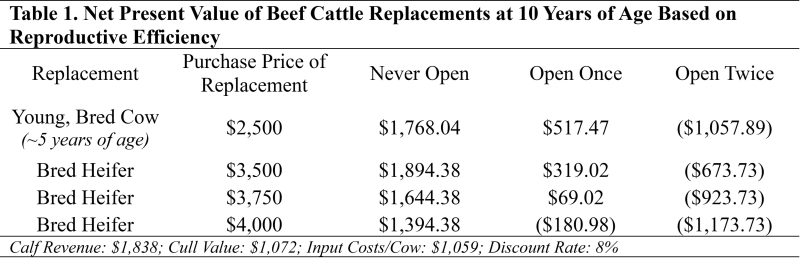
Whether buying or retaining heifers, rebuilding efforts are going to be a large investment over the next couple of years. Investments involve risk, so it is important to analyze that risk using tools such as Net Present Value (NPV). Credit: AdobeStock_433602284
Due to current inventory levels, producers are beginning to think about expansion. Because of this, the value of young cows and heifers is increasing as demand for breeding stock increases. On average, bred heifers are selling between $3,500 – $4,000 per head with the cost of raising your own replacements not being far off from that range, when considering the opportunity cost of keeping a weaned heifer calf.
Whether buying or retaining heifers, rebuilding efforts are going to be a large investment over the next couple of years. How can we know if this investment is financially feasible for future profitability?
Recently, in an article published by Dr. James Mitchell and Dr. Ryan Loy, at the University of Arkansas, about using Net Present Value (NPV) to analyze the long-term profitability of buying replacement heifers while accounting for the time value of money. They make the point that it is important to “test a range of scenarios [when using NPV] by adjusting calf prices, input costs, reproductive performance, the discount rate, and cull value to reflect [a specific] operation.” This article takes their scenario a step further by adjusting reproductive performance to illustrate the importance of reproductive efficiency after you make the investment.
If it is financially feasible to buy or retain replacement heifers, the investment doesn’t stop there. The hardest year for a heifer to get rebred is with her second calf. A first-calf heifer needs to get rebred within about 83 days after calving—while still growing and raising her first calf. So, are we prepared to make investments or decisions to ensure she gets rebred that second time? An open cow, regardless of age, often costs more than she earns over time. Below are a few considerations when thinking about the long-term productivity and profitability of replacements.
- Do we have solid nutrition and forage programs that are going to meet her requirements?
– - Have we considered management plans (e.g., early weaning) to help her recover and rebreed?
– - If using natural service, are our bulls sound? If using AI, have we selected an appropriate synchronization protocol?
–
Table 1 below illustrates the Net Present Value (NPV) of buying beef cattle replacements based on purchase price and reproductive efficiency. The scenarios of reproductive efficiency are 1) never open during a 10-year productive life, 2) open once, and 3) open twice. The assumptions are:
- A young, bred cow open once missed her fifth year (cull year).
- A young, bred cow open twice missed her second and fifth year (cull year).
- A bred heifer open once missed her second year.
- A bred heifer open twice missed her second and eighth year (cull year).
As expected, NPV declines as the purchase price increases, except when comparing the young, bred cow to a $3,500 bred heifer. This is because the bred heifer presumably stays in the herd longer, giving her more time to increase her net returns. The table includes young, bred cows as an alternative risk management strategy. This is not to say a young, bred cow will not come up open, especially if that is one of the reasons she is being sold. (It is important to buy replacements you can obtain history on.) However, she will be more “seasoned” than a bred heifer, making it safe to assume she may come with less risk and pressure from a rebreeding standpoint.
We can see from Table 1 that NPVs decline as reproductive efficiency declines. While NPVs are still positive for those who missed one year (excluding the $4,000 heifer), it is important to note that calf prices, cull values, and discount rates did not vary year by year in this 8-year scenario. If any of those variables change, it will positively or negatively affect these values. The key point is that market prices will inevitably fluctuate, influencing profitability. However, not having a calf to sell results in a more significant negative impact on profitability.
Having a cow that never comes up open is an ideal cow, but maybe not a realistic goal. There are many factors – some controllable, some not – that influence a cow’s reproductive performance. In today’s market, adopting management strategies that increase the chances of having a calf every year is essential to making sure investments in young breeding stock lead to future returns. So, the takeaways from this article are to:
- Analyze your decision to rebuild your herd. Investments involve risk, so it is important to analyze that risk using tools such as Net Present Value (NPV).
– - If you are going to start rebuilding, analyze your plan for efficiently and economically controlling factors related to reproductive efficiency, especially for first-calf heifers.
–
Mitchell, J. and R. Loy. 2025. “Investing in Herd Expansion: Time Value of Money and Opportunity Cost.” Cattle Market Notes Weekly.
- The Economic Influence of Intentional Management of Your Cow Herd - December 19, 2025
- December 2025 Florida Cattle Market Update - December 19, 2025
- October 2025 Florida Cattle Market Update - November 7, 2025

